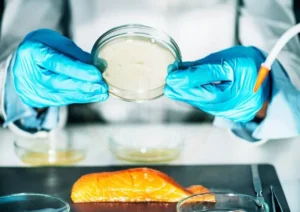What is Salmonella Enteritidis Bacteria?
Getting to Know Salmonella Enteritidis:
What Causes It, What to Look For, and How to Stay Safe
Salmonella Enteritidis is one of the most common types of bacteria that causes foodborne illnesses around the world.
It’s part of the Salmonella family, which has over 2,500 different types,
but Salmonella Enteritidis is particularly known for causing infections mainly through contaminated food like eggs, chicken, and dairy.
In this guide, we’ll dive into:
What Salmonella Enteritidis is
How it spreads
Common symptoms of an infection
How to treat and prevent it
Why it’s a big deal for public health
By the end of this article, you’ll have a good grasp on this harmful bacteria and some tips to keep yourself safe from getting infected.
What is Salmonella Enteritidis?

Salmonella Enteritidis is a Gram-negative rod-shaped bacteria that causes gastroenteritis in people.
It’s one of the top causes of food poisoning often linked to raw or undercooked eggs,
poultry, and unpasteurized milk.
Unlike some other Salmonella types,
Enteritidis can infect hens’ ovaries which can contaminate eggs before they’re even laid.
Key Traits of Salmonella Enteritidis:
Type: Bacteria (Salmonella species)
How it spreads: Through food (eggs, poultry, meat, dairy)
Incubation time: 6 hours to 6 days
Common symptoms: Diarrhea, fever, belly cramps
At-risk people: Kids, older adults, those with weak immune systems
How Does Salmonella Enteritidis Spread?
Salmonella Enteritidis mainly spreads through:
1. Contaminated Food
Raw or undercooked eggs (like in homemade mayonnaise or cookie dough)
Undercooked poultry and meat
Unpasteurized milk and dairy
Contaminated fruits and veggies (through bad water or soil)
2. Cross-Contamination
Using the same cutting board for raw chicken and veggies
Not washing hands after handling raw eggs or poultry
3. Person-to-Person Spread
Not washing hands after using the bathroom
Fecal-oral route (makes these germs spread easily in daycare settings)
4. Infected Animals
Reptiles (like turtles and lizards) and poultry can carry Salmonella and show no signs of illness.
Symptoms of Salmonella Enteritidis Infection

Most people who get sick from Salmonella Enteritidis start to feel symptoms
within 12 to 72 hours after getting exposed.
The illness called salmonellosis usually lasts 4 to 7 days and can include:
Diarrhea (sometimes bloody)
Fever (100.4°F or higher)
Belly cramps
Nausea and vomiting
Headaches and muscle pain
In more serious cases, the infection can spread beyond the intestines which could lead to bacteremia (blood infection).
That needs to be treated right away.
Who is at Higher Risk?
Infants and young kids
Older adults
People with weak immune systems (like those with HIV or people getting chemotherapy)
Those on acid-reducing meds (stomach acid is important for killing Salmonella)
Diagnosis and Treatment
Diagnosis:
Doctors usually figure out if you have Salmonella Enteritidis by:
Stool culture (the most common method)
Blood tests (if the infection has spread)
Treatment:
Most healthy folks get better without needing antibiotics, but treatment might include:
Staying hydrated (oral rehydration solutions or IV fluids if it’s severe)
Antibiotics (for serious cases or patients at high risk)
Probiotics (to help restore good gut bacteria)
Note: Using antibiotics too much can cause resistant Salmonella strains to develop.
How to Prevent Salmonella Enteritidis Infection
1. Safe Food Handling
Cook eggs, poultry, and meat well (internal temp: 165°F for chicken, 160°F for ground meat).
Avoid raw or undercooked eggs (like homemade Caesar dressing or cookie dough).
Wash fruits and veggies before you eat them.
2. Preventing Cross-Contamination
Use different cutting boards for raw meat and veggies.
Wash hands utensils and surfaces after handling raw foods.
3. Good Hygiene Practices
Wash hands with soap for 20 seconds after going to the bathroom changing diapers or handling animals.
4. Be Careful with High-Risk Foods
Avoid unpasteurized milk and juices.
Keep eggs in the fridge (below 40°F).
Why is Salmonella Enteritidis a Public Health Concern?

Salmonella Enteritidis leads to millions of infections every year,
with some people needing to go to the hospital and,
in worst cases, it can even lead to death, especially in vulnerable folks.
Outbreaks usually happen because of:
Contaminated food (like when eggs or chicken are recalled)
Bad hygiene in restaurants
Global food distribution (which spreads these bacteria all over the world)
Health agencies like the CDC and WHO keep an eye on outbreaks and enforce rules for food safety to keep infections down.
Wrapping Up
Salmonella Enteritidis is a dangerous foodborne bug but it’s avoidable.
By sticking to good food safety practices, you can really lower your chances of getting infected.
Always cook your food well, keep things clean, and stay up to date on food recalls.
If you have severe symptoms (like high fever bloody diarrhea or dehydration), get medical help right away.
HOSTINGER HOSTING PLAN DISCOUNT CODE

2 thoughts on “What is salmonella enteritidis bacteria?”